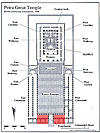


 The
Propylaeum is the monumental entrance gateway to the temple precinct.
It consists of a flight of steps leading into the hexagonally-paved Lower
Temenos.
The
Propylaeum is the monumental entrance gateway to the temple precinct.
It consists of a flight of steps leading into the hexagonally-paved Lower
Temenos.
Although the Propylaeum Steps have been surveyed, their dates and construction have not been securely phased. The Temple Complex underwent dramatic spatial changes during its life span, and these are also reflected in the Propylaeum Steps. Their present appearance is not to be confused with the original access to the precinct, for they post-date the erection of the east-west retaining wall facing the Colonnaded Street. Subsequently modified after the street was paved in ca. 76 CE, their present orientation reflects their re-building at the same time or slightly later than the Street. At that time, they served as the entrance from the street into Temple Precinct. The location of the earliest Propylaeum entrance is problematic; specific dates for the construction of these steps is unclear. Further archaeological investigations will be designed to locate structural evidence in this area.
The Propylaeum Steps
are in a state of disarray, however, the lower eight steps that face the
Colonnaded Street seem to stand largely as they were in antiquity. The
upper steps are largely eroded.
 |
| The Propylaeum steps (looking south). |
To the west of the Propylaea Steps, an arched walkway or corridor, was found in 1998, which was constructed parallel to the Colonnaded Street, was excavated by Katrina Haile in Trench 51 to a 3.50 m depth. Between the upper and lower east-west retaining walls, this corridor was constructed earlier than the present day steps leading from the Colonnaded Street into the Temple precinct. The excavators noted that the Propylaea Steps wall was constructed with a number of voussoirs (arch ashlars), and that the upper east-west retaining wall was an original terrace wall of the precinct. The lower retaining wall, however, was probably contemporary to the building of the steps and the Colonnaded Street. These observations will have to be confirmed by future excavation.
 |
| The Propylaeum, the Colonnaded Street at bottom, the Lower Temenos at top. |
Large amounts of roof tiles suggest that this area was originally covered. Tesserae were found as well as decorative plaster and coins. Architectural fragments numbered 75, and of these six elephant sculptural elements were recovered, which suggests that the elephant capitals associated with the Lower Temenos colonnades also may have been part of the Propylaeum architectural program.
Recent consolidation efforts have been made to facilitate visitor-tourist access from the Colonnaded Street to the Great Temple's Lower Temenos.



